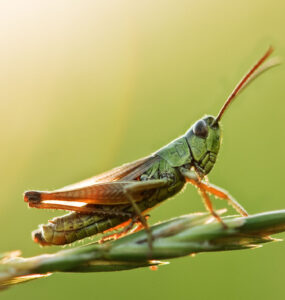Mosquito Repelling Plants
by Rob Sproule
Our late night summer sun is one of the sweetest things about living Alberta. Sitting on a warm 9pm patio and letting the day drain away like cold beer almost (almost) makes our winters worth it. With long days, however, come the skeeters.
From the days of the Voyageurs, who rubbed skunk urine on their skin and hung spruce boughs around their necks, and with our increasing skepticism about rubbing DEET on our skin, Canadians have been finding creative ways to keep skeeters at bay.
By far, citronella is the most popular natural solution available today. With all the “buzz” about citronella based plants and products, lately, I thought I’d flesh it out for you.
What is Citronella
Citronella oil, the active ingredient in countless consumer products from soap to candles to dog collars, is a registered and proven insect repellent (according to the USDA). It’s derived from Cymbopogon (Lemongrass), and is recognized as one of the safest repellants for mosquitos and other creepy nasties””one benefit of plant-based products.
Mosquitoes avoid the lemony smell (which is luckily more appealing than skunk urine to us). Burning a citronella candle works well to keep them away as long as you’re in a partly enclosed area, like a deck or patio with at least oe wall. In an open yard the wind will simply carry the scent away.
Citronella Geraniums
Citronella geraniums, or Citrosa, were developed with the idea of capturing citronella in a plant to keep mosquitoes away. It’s become famously popular thanks to lot of buzz, but it’s only effective if you use it the right way.
Citrosa’s lemony scent is what keeps the skeeters away, and while sitting there is emits very little of it. If you put it in a planter, make sure it’s only a few feet from where you like to sit and in a partly sheltered area.
The most effective way to use it is to actually break the leaves up and wipe them on your skin. Unfortunately, while you’ll smell lemony fresh, it has to be applied every hour and your geranium will be naked very quickly.
The best way to use Citronella is to blend it into the mixed container gardens that you have around you on the patio in the evenings, effectively creating a lemon scented perimeter while you enjoy your wine. Ideally, blend in some other mosquito deterring plants to reinforce your defence!
Other Effective Plants
People tend to think that the only plant that naturally repels mosquitoes is citronella geraniums and are surprised to learn how many plants there are. It’s true that many of the others have neither the “street-cred” nor the marketing that citronella has, but they are effective nonetheless.
Catnip
Catnip contains a naturally occurring insect repellent (nepetalactone), which is effective at keeping most creepy-crawly and flying pests out of the vicinity. Spreading fresh catnip leaves in an ant-infested area is a useful, though temporary, way of taking telling them they aren’t welcome.
Marigold “˜Lemon Gem’
These are classic marigolds that combine the pest-controlling benefits of French marigolds with a statuesque habit and lacy leaves punctuated by scores of single, yellow sundrop flowers, which are edible. It will grow easily in full sun into a bushy filler plant, contributing finely cut leaves to the overall architecture. You’ll notice a lemony fragrance surrounding it; it’s a natural mosquito deterrent.
Ageratum
Also called “˜Floss Flower’ this little plant provides mounds of colour all summer and has better heat tolerance than its predecessors. It’s not edible but it does deter mosquitoes by emitting the chemical coumarin, which the flying pests hate. Ageratum is an excellent addition for a splash of colour.
















